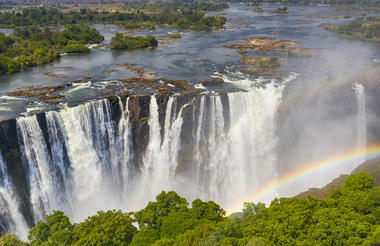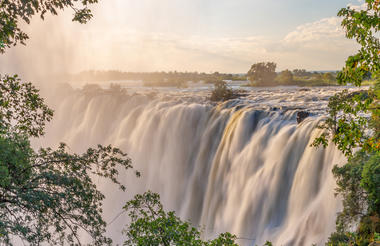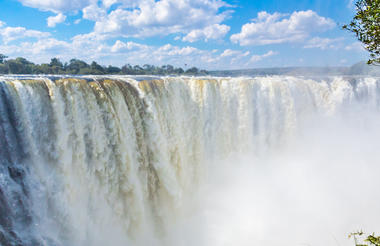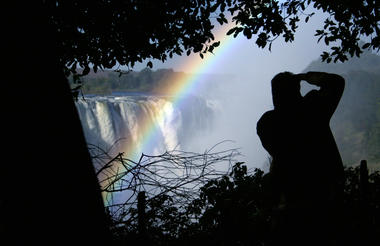Habitat: The Manuchira Channel is known as the Khwai River at its eastern most extremity. The day’s journey follows this water course, with the track weaving from the riverside and floodplains into the mopane veld and the woodlands that make Khwai one of the most scenic areas of the Okavango. We pass the magnificent Dombo Hippo Pools in the morning stopping to enjoy the scenery and the antics of the resident hippo.
Wildlife: The western mopane veld is home to mostly breeding herds of elephant whilst the eastern reaches of Khwai is home to some impressive old bulls. The mature bulls revel in the cool waters of the Khwai and are far more approachable while drinking and bathing than the breeding herds. The river has an unusually high density of hippo as well as some huge crocodile. Leopard, cheetah, serval and lion are common predators along this route and both Xakanaxa as well as Khwai are included in the home ranges of 2 different packs of wild dog.
General game includes southern giraffe, Burchell’s zebra, tessebe and red lechwe with roan and sable antelope being less common residents.
Birding: In the mopane woodlands African Hawk-Eagle, Tawny Eagle, Gabar Goshawk, Little Sparrowhawk, African Harrier Hawk and Shikra are common raptors. Mixed bird parties move through the canopy and include Red-headed Weaver, Stierling’s Wren-Warbler, Scarlet-chested Sunbird, Neddicky, Yellow-breasted Apalis, Chin-spot Batis, Diederik Cuckoo* to name but a few. The verges of the swamp form breeding grounds for the Rosy-Longclaw, Black Coucal*, Long-legged Bustard and the African Crake*



Habitat: Unlike the vast majority of the country, Central Chobe is not flat landscape. Large outcrops of volcanic rock reach up out of the Kalahari sands, towering over the endless savannah. These hills provide habitat for a completely different array of small wildlife, birds and plants. The Savuti Marsh has been the stage for many of the most dramatic wildlife documentaries in Africa. The wide open country, good ungulate populations and particularly strong prides of lion and hyaena clans make for dramatic wildlife interaction and excellent viewing opportunities. The now dry Savuti Channel runs through this landscape linking the drysandveld, the waterholes, the hills and the grassland that was the Savuti Marsh.
Wildlife: Undoubtedly it is the interaction between lion and elephant that is the most interesting aspect of Savuti. The area is inhabited by a huge pride of lions with numbers fluctuating from 20-30 members. These remarkable lion have learned over the years how to hunt these massive pachyderms that are supposedly above predation. Launching their attack under darkness and using their numbers, they manage to kill adolescent and even young adult elephant. The marsh is prime cheetah country and in the wet season it is not unusual to have the wild dog hunting here in Central Chobe.
Birding: The surface water that is pumped by the Government here provides a major attraction for birdlife. In the dry season thousands of dove and sandgrouse come down to drink in the mornings and are under constant surveillance by Yellow-billed Kite*, Tawny Eagle and African Hawk-Eagle. Red-crested Korhaan are common in the Kalahari Apple-leaf (Lonchocarpus nelsii) veld. The marsh is the summer home for good numbers of Caspian Plover* and Montague’s Harrier* as well as Chestnut-backed Sparrowlark, Grey-backed Sparrowlark, Northern Black Korhaan, Rufous-naped Lark, African Pipit and Desert Cisticola. Dickenson’s Kestrel, Amur Falcon* and Red-necked Falcon are found along the
perimeter of the marsh.



Game Drive
Bushman Painting Walks
Habitat: The Manuchira Channel is known as the Khwai River at its eastern most extremity. The day’s journey follows this water course, with the track weaving from the riverside and floodplains into the mopane veld and the woodlands that make Khwai one of the most scenic areas of the Okavango. We pass the magnificent Dombo Hippo Pools in the morning stopping to enjoy the scenery and the antics of the resident hippo.
Wildlife: The western mopane veld is home to mostly breeding herds of elephant whilst the eastern reaches of Khwai is home to some impressive old bulls. The mature bulls revel in the cool waters of the Khwai and are far more approachable while drinking and bathing than the breeding herds. The river has an unusually high density of hippo as well as some huge crocodile. Leopard, cheetah, serval and lion are common predators along this route and both Xakanaxa as well as Khwai are included in the home ranges of 2 different packs of wild dog.
General game includes southern giraffe, Burchell’s zebra, tessebe and red lechwe with roan and sable antelope being less common residents.
Birding: In the mopane woodlands African Hawk-Eagle, Tawny Eagle, Gabar Goshawk, Little Sparrowhawk, African Harrier Hawk and Shikra are common raptors. Mixed bird parties move through the canopy and include Red-headed Weaver, Stierling’s Wren-Warbler, Scarlet-chested Sunbird, Neddicky, Yellow-breasted Apalis, Chin-spot Batis, Diederik Cuckoo* to name but a few. The verges of the swamp form breeding grounds for the Rosy-Longclaw, Black Coucal*, Long-legged Bustard and the African Crake*
The Khwai River forms a boundary between the reserve and the community area. We spend the following two nights camping at an exclusive campsite in the community area, exploring the Khwai floodplains on game drives both during the day and at night. Exploring after dark with spotlights offers you an opportunity to experience some of the nocturnal animals that are rarely encountered during the day. We will also have the opportunity to explore the surrounding wilderness on foot and mokoro and enjoy an up close and personal encounter with Botswana’s flora and fauna. It is important to note that night drives and guided walks are not permitted within the national parks and reserves.
These activities are conducted outside the boundaries of the Moremi Game Reserve in the Khwai community area.
Habitat: We spend our time between the dry-land habitats of the leadwood and camel-thorn woodlands and savannahs and the riverside and marshy back-waters of the Khwai. Time permitting we may visit the lagoons and waterways of Xakanaxa where the largest heronry in southern Africa exists.
Wildlife: The Khwai region boasts excellent populations of both bull elephant as well as breeding herds. Lion, leopard, serval and African wildcat are common predators of the region with
wild dog and cheetah being less common. Buffalo use this area seasonally with large herds moving in during the summer
rains. The swampy areas in the west are home to red lechwe. Other ungulates include tsesebe, blue wildebeest, giraffe,
kudu, sable antelope, roan antelope and impala.
Birding: Truly one of Botswana birding Mecca’s. The western reaches are prime habitat for the uncommon Rosythroated Longclaw. The entire length of the river is hunting domain for the Bat-Hawk. Other interesting raptors here are
Cuckoo Hawk (rare), Long-crested Eagle and Black Sparrowhawk. More commonly Tawny Eagle, Steppe Eagle*, Lesser-spotted Eagle*, Martial Eagle, Bateleur and African Hawk-Eagle. The waterways host Africa Rail, African Crake*, Greater Painted Snipe, Allen’s Gallinule*, Lesser Jacana and Lesser Moorhen*
Game Drives
Walking Safaris
Night Drives
Mokoro Excursions
Habitat: The Manuchira Channel is known as the Khwai River at its eastern most extremity. The day’s journey follows this water course, with the track weaving from the riverside and floodplains into the mopane veld and the woodlands that make Khwai one of the most scenic areas of the Okavango. We pass the magnificent Dombo Hippo Pools in the morning stopping to enjoy the scenery and the antics of the resident hippo.
Wildlife: The western mopane veld is home to mostly breeding herds of elephant whilst the eastern reaches of Khwai is home to some impressive old bulls. The mature bulls revel in the cool waters of the Khwai and are far more approachable while drinking and bathing than the breeding herds. The river has an unusually high density of hippo as well as some huge crocodile. Leopard, cheetah, serval and lion are common predators along this route and both Xakanaxa as well as Khwai are included in the home ranges of 2 different packs of wild dog.
General game includes southern giraffe, Burchell’s zebra, tessebe and red lechwe with roan and sable antelope being less common residents.
Birding: In the mopane woodlands African Hawk-Eagle, Tawny Eagle, Gabar Goshawk, Little Sparrowhawk, African Harrier Hawk and Shikra are common raptors. Mixed bird parties move through the canopy and include Red-headed Weaver, Stierling’s Wren-Warbler, Scarlet-chested Sunbird, Neddicky, Yellow-breasted Apalis, Chin-spot Batis, Diederik Cuckoo* to name but a few. The verges of the swamp form breeding grounds for the Rosy-Longclaw, Black Coucal*, Long-legged Bustard and the African Crake*
Habitat: Moremi lies on the eastern extremity of the Okavango Delta. Habitats here range from wide-open floodplains, marshes, lagoons, papyrus fringed channels, vast reed-beds of Miscanthus and Phragmites, woodland and savannah. As a result of the extremely variable habitat the diversity of both wildlife and birdlife is excellent.
Wildlife: Every type of mopane habitat is well represented in this drive from the towering cathedral woodlands Xakanaxa to the classic climax mopane woodland and in the drier and harsher habitats, extensive stretches of scrub mopane. The San-ta-Wani region has scattered ephemeral water pans with large floodplains and camel-thorn woodlands. 40 km of the drive is in Moremi Game Reserve with a further 40 km in areas designated for wildlife management where animals roam freely to and from the Game Reserve.
Birding:A good day for raptors with African Hawk-Eagle, Gabar
Goshawk, Shikra, Little Sparrowhawk, Dark Chanting Goshawk,
Tawny Eagle, Lesser Spotted Eagle* and Steppe Eagle* all inhabiting the mopane and adjacent woodlands. Other birds common along this route includes most of Botswana’s hornbills including Red-billed, Southern Yellow-billed, African Grey, Bradfield’s and the Southern Ground Hornbills. A large number of brood-parasites may also be seen. Diederick Cuckoo*, Levaillant’s Cuckoo*, Jacobin Cuckoo*, Great-spotted Cuckoo*, African Cuckoo*, Common Cuckoo*, Shaft-tailed Whydah, Pin-tailed Whydah, Eastern Paradise Whydah, Greater Honeyguide, and
Lesser Honeyguide.
Game Drive
Following breakfast and an early morning game drive, you will be taken to the airstrip for your charter flight back to Maun arriving at approximately 12h00 for your onward flight to Victoria Falls.
Once you are settled (depending on arrival time) you will meet a professional guide and
spotter for an afternoon game drive. Using an open four-wheel drive vehicle, the game drive
allows you to discover many interpretations of the bush and all its inhabitants, related to them
by our suitable trained and qualified guides. This is an uncontrived bush experience, covering a
genuinely wild, unfenced wilderness area.



• Accommodation, all meals and drinks + complimentary mini bars in the rooms
• Transfer from Victoria Falls Airport to the lodge
• Laundry
• Morning and Afternoon Game drives in the Zambezi National Park
• Morning and Afternoon River Safaris
• Guided Walking Safaris
• Lunch at the Lookout Cafe - Including drinks
• Guided Tour of the Falls – Zimbabwe
1. Enjoy a morning game drive with some hot drinks and the sunrise. Afterwards you will be taken back to the lodge where a scrumptious breakfast will be awaiting you.
2. Embark on a spectacular morning tour of the Falls. Proudly referred to as Mosi-oa-Tunya or 'The Smoke that Thunders' by the locals; Victoria Falls has a combined width of 1,7 kilometres (approx. 1 mile) and height of 100 metres (330 feet), making it one of the world’s largest waterfalls and one of the seven natural wonders of the world. Remember your raincoats! – it does get quite wet.
3. Complimentary lunch at the Lookout Café - Perched 120 metres above the turbulent rapids of the Zambezi River, the café overhangs the spectacular chasm of the Batoka Gorge, just down from the iconic Victoria Falls Bridge, which forms part of its backdrop.
4. Old Drift has two luxury 10-seater pontoon boats which you board for an exciting afternoon river safari where you will enjoy drinks and snacks with a breath-taking view.
5. You will be back at the lodge in time to enjoy dinner



Embrace in your final African sunrise during a morning game drive. After breakfast you will be met by your private driver from Old Drift Lodge who will transfer you to Victoria Falls Airport where you will board your flight back home.




